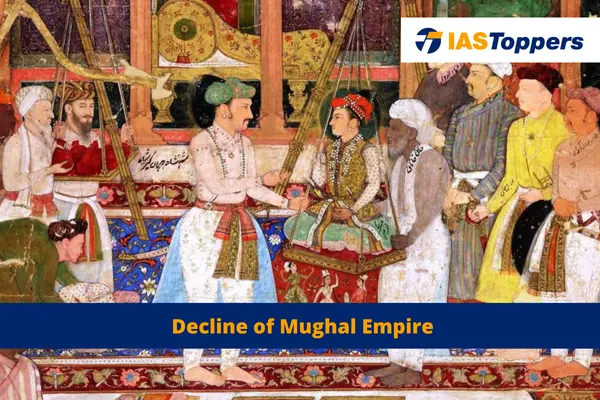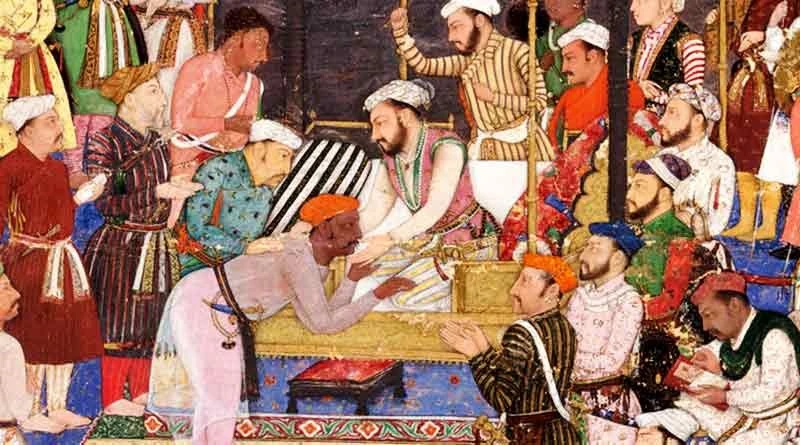Decline of Mughal Empire has begun since the reign of Muhammad Shah in the 18th century. Many of its territory were being controlled by the Marathas and later on by the Britishers. In this article, you will learn about reasons for decline of Mughal empire in India, effects of such decline on Indian History, providing key insights for GS Paper- I Art and Culture section of UPSC IAS Exam.
Table of Content
- Table of Content
- Background before Decline of Mughal Empire
- Weak Succession after Aurangzeb
- Succession of Mughal Empire after Aurangzeb
- Causes of decline of Mughal Empire
- Role of Aurangzeb in decline of Mughal empire- Persecution:
- Demoralization of the Mughal Army
- Economic Bankruptcy
- Foreign Invasions
- Empire Size and Challenges from Regional Powers
- Aurangzeb’s Deccan Policy
- The Jagirdari Crisis
- Conclusion
- Frequently Asked Questions
- Reference
Background before Decline of Mughal Empire
- The era of the Great Mughals has begun in 1526A.D. from the empire of Humayun.
- The Mughal decline has begun after the passing away of Aurangzeb in 1707A.D.
- Though the actual declination of Mughal Empire is said to have began in the 18th century, during the reign of Muḥammad Shah (1719–48).
- The decline and disintegration of Mughal empire that began during Aurangzeb’s rule could not be halted by his weak successors, and the power struggles amongst other regional rulers during that time.
- The Mughal army also suffered due to a lack of capable commanders, and no technological advancements after Akbar’s reign.
Succession of Mughal Empire after Aurangzeb
Causes of decline of Mughal Empire
- During the reigns of Akbar, Jahangir, and Shahjahan, they had many influential figures in their courts such as Bairam Khan, Munim Khan, Muzaffar Khan, Abdur Rahim Khan Khana etc.
- However, as the later Mughal emperors’ position declined, the quality of nobility also declined.
- The wealth and leisure acquired by nobility made them spend more time in luxury and indolence, which further declined their quality.
- The nobility started getting divided on the basis of religion, homeland, and tribe.
- Each group of nobility pursued its own interests causing mutual rivalry, jealousy, and power struggles as there was a lack of strong central leadership.
Weak Succession after Aurangzeb:
- The Mughal rulers did not follow a specific succession law like law of primogeniture.
- This resulted in a power struggle between brothers for the throne every time a ruler passed away.
- This weakened the Mughal Empire especially after Aurangzeb’s reign.
- The nobles had aligned themselves with different contenders to increase their own influence.
- The successors of Aurangzeb were feeble and fell prey to the plots of the faction-intended nobles.
- They lacked military prowess and cannot even suppress revolts easily.
- The absence of a strong ruler, an efficient bureaucracy, and a capable army had altogether weakened the Mughal Empire.
Role of Aurangzeb in decline of Mughal empire:
- Aurangzeb had failed to recognize that the Mughal Empire can only survive on the willing support of the people.
- He alienated the Rajputs, who had earlier played a significant role in the Empire’s strength.
- Rajputs had been loyal defenders of the throne, but Aurangzeb’s policies turned them into bitter foes.
- Wars with the Sikhs, Marathas, Jats, and Rajputs had depleted the Mughal Empire’s resources.
- Aurangzeb had reinstated the jiziya tax on Hindus which made Rajputs turned against him.
Demoralization of the Mughal Army:
- The Mughal army that was originally strong and well-structured, became weak and flawed.
- It primarily consisted of contingents recruited and maintained by high-ranking officials and nobles who used to receive revenues from large territories for their maintenances.
- The individual soldiers considered their mansabdar (commander) as their chief rather than an officer.
- There was little interaction between the emperor and the soldiers, as the soldiers were paid by their commanders and not directly from the royal treasury.
- These flaws were more pronounced during Aurangzeb’s reign and those of his successors.
- As the authority of the later Mughal emperors weakened, the nobles transformed their assignments of maintaining troops into hereditary possessions.
- Mughal officers after the late 17th century started engaging in treacherous activities with the enemy.
- With the lack of discipline and regular punishments, the army became ineffective for both offense and defense.
- There was lack of any major technological advancement of military based equipments.
Economic Bankruptcy:
- The luxurious lifestyle and prolonged wars fought by Shah Jahan and Aurangzeb in the south had drained the exchequer.
- The number of amirs and their ranks or mansabs had sharply increased this led to a scarcity of available land for distribution as jagirs among them.
- Aurangzeb had also presented inflated income from recorded jagirs, which pressurised jagirs to increase the tax on farmers.
- The state demand for half of the agricultural produce resulted in decreased production as cultivators started abandoning their fields.
- Despite being compelled to continue cultivation, bankruptcy became common amongst the farmers of Mughal government.
- Also, there were decrease in khalisa land.
- The economic collapse reached its peak during the reign of Alamgir II, who faced starvation as even the revenues from the royal estate were usurped by the Wazir Imad-ul-Mulk.
- The stagnant economy lacked any scientific and technological advancements that may have led to growth.
- The bankrupt Mughal government managed to survive only for another 50 years.
Foreign Invasions:
- Foreign invasions further weakened the Mughals and increased their disintegration.
- Nadir Shah and Ahmad Shah Abdali’s invasions has led to a significant drain on the Empire’s wealth and shook their stability.
Empire Size and Challenges from Regional Powers:
- The Mughal Empire had grown so vast that it cannot be effectively controlled from a single center– Delhi.
- While the earlier Mughals can efficiently control their ministers and the army, the later Mughals were poor administrators.
- During Aurangzeb’s reign, various influential regional groups such as the Jats, Sikhs, and Marathas challenged the authority of the Mughal state in order to establish their own kingdoms.
- Aurangzeb and later Bahadur Shah I’s attempts to suppress the Rajputs led to the battles between the Rajputs and the Mughals.
- The later Mughal rulers tried to reconcile with the Rajputs, but Rajputs has already lost the trust.
- The Marathas had secured legal permission from the Mughal emperor to collect sardeshmukhi and chauth taxes throughout India.
- This led expansion of Marathas northwards and by 1740, they had gained control over the provinces of Gujarat, Malwa, and Bundelkhand.
- This led to distant provinces gained independence, and the rise of independent states contributed to the Empire’s disintegration.
Aurangzeb’s Deccan Policy:
- Aurangzeb’s Deccan policy led to the death of many skilled soldiers which then damaged Mughal prestige.
- He annihilated the Shia Kingdoms of Bijapur and Golconda and also waged a prolonged and futile war against the Marathas.
- This compelled the Marathas to defend themselves, and their successes encouraged them to launch more offensive war and invade Mughal provinces in Northern India.
- Aurangzeb’s policy of religious persecution had already alienated the Hindu officers and vassals who either became indifferent or hostile to the Mughals.
- The Marathas capitalized on this and sought after support from the Rajputs and other Hindus to strike at the Mughal Empire.
- After Aurangzeb’s death, his successor fought against the Sikhs, Jats, Bundelas, Rathores, Kachhwahas, and Sisodias, as no Hindu military allies were on the Mughal side.
- Aurangzeb’s absence in Northern India allowed many provincial governors to become independent, resulting in regional instability.
The Jagirdari Crisis:
- The Mughal Empire had a highly centralized bureaucratic structure, with the emperor being at the top and the military aristocracy below them.
- The introduction of the mansabdari system in the late 16th century also accommodated the civil aristocracy within this structure.
- Mansabdars who were not paid in cash received jagirs, or landed estates, as a form of salary.
- Jagirdars were responsible for collecting revenue from their specific jagirs.
- A portion of jagirs also went to the state and the rest were used by Jagirdars as their personal expenses, and allowances for soldiers and horses.
- The zamindars or jagirdars were also known by various titles such as rais, rajas, thakurs, khuts, or deshmukhs.
- Towards the end of Aurangzeb’s reign, the number of jagirdars appointed had increased causing a shortage of available land for granting jagirs.
- The scarcity in land strained the relationship between the emperor and the aristocracy, which made the Mughal administrative system inefficient.
- Many local zamindars had started aiding the nobility and the other influential class within the empire, leading to further declination of Mughal empire.
- Top of Form
Conclusion
The major causes of decline of Mughal Empire in conclusion can be attributed to many factors such as lack of a clear succession law, nobles gaining more power and becoming treacherous, moral decay of administrators among others. The effect of decline of Mughal empire was such that it has resulted in rise of British empire in India.
Ref: Source-1
| Other Articles in History & Culture | |
| Indo-Islamic Architecture | Battle of Plassey 1757 |
| Battle of Buxar(1764) | Subsidiary Alliance System |
| Maratha Empire | Miniature painting |
FAQs (Frequently Asked Questions)
What factors led to the decline of the Mughal empire?
The factors for the decline of Mughal empire were weak succession or rulers after Aurangzeb, decline in quality of the Mughal nobility, religious persecution and taxes, no scientific advancement in Mughal army and weaponry, economic bankruptcy due to lavish life of the rulers, foreign invasions from Western India, Jagirdari crisis, challenges from regional emerging powers etc.
How Mughal empire declined?
The Mughal Empire has began to decline since the reign of Muhammad Shah in the 18th century. Many of its territory were being controlled by the Marathas and later on by the Britishers. The last Mughal emperor, Bahadur Shah II (1837–57), was exiled by the Britishers after the Indian Mutiny in 1857.




